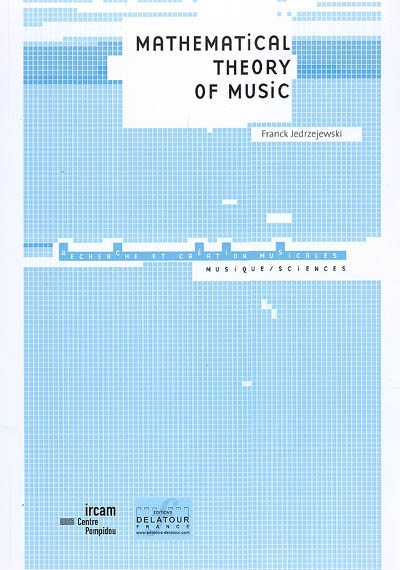en savoir plus

Carte fidélité
Permet à tous ses détenteurs d'obtenir 5% de réduction sur tous les livres lors du retrait en magasin (réduction non cumulable avec les réductions de type étudiant).
Offre également un certain nombre d'avantages auprès de nos partenaires.
Wishlist
Avec les favoris, retrouvez dans un espace les sélections effectuées au fur et à mesure de vos navigations dans le site.
Constituez pour votre usage personnel vos listes de livres en prévisions d'achats futurs et votre sélection d'articles, dossiers, événements, vidéos ou podcasts préférés ou à découvrir plus tard...
Il suffit simplement de cliquer sur "Ajout Favori" sur chaque page qui vous intéresse pour les retrouver ensuite dans votre espace personnel.
Requiert un compte Mollat
Mes Alertes
Requiert un compte Mollat
Mathematical theory of music
Auteur : Franck Jedrzejewski
en savoir plus
Résumé
L'ouvrage démontre l'utilisation des outils mathématiques dans la théorie et l'analyse musicale, en tant qu'alternatives des méthodes empiriques. ©Electre 2025
Lire la Quatrième de couverture
Réduire la Quatrième de couverture
Musique / Sciences
Mathematical Theory of Music
This book provides a unified account of mathematical tools for music theory and analysis, as alternatives to empirical methods. It constitutes a unique reference. The first chapters of the book take as its subject the staple (basic, essential, age-old...) topics in systematic musicology : harmonic and sonance models, Helmholtz research, Costère affinity models as well as chords and scales taxonomy using group action method. Messiaen's limited transposition modes are generalized to n-tone equal temperament.
Methods reviewed by the author briefly include the popular techniques of Forte set theory and Lewin generalized interval systems. The legacy of Hugo Riemann is evoked via the new definition of Riemannian transformations with permutations, which appear in mathematical music theory as carriers for models of some musical objects, as well as for the semantics of other types of musical logic. Neo-Riemannian investigations also provide new interpretations in the design of chords lattices and isographies.
Among the novel features of this book are diagrammatic representations of knots and braids. Schoenberg series are mapped to singular knots. The appendix gives the complete classification of the twelve tone rows in chord diagrams.
In the chapters devoted to tuning and temperaments, the hierarchical organization of contemporary tunings and historical temperaments is studied under various refinements of fundamental concepts : continued fractions, harmonic distance and tuning groups. In the last chapter, the relationships between tilings and canons are related to groups and topology.
This book will be of value to graduate students and research workers in systematic musicology.
Fiche Technique
Paru le : 01/06/2006
Thématique : Histoire de la musique, Essais
Auteur(s) : Auteur : Franck Jedrzejewski
Éditeur(s) :
Ed. Delatour France
IRCAM-Centre Georges Pompidou
Collection(s) : Musique-sciences
Série(s) : Non précisé.
ISBN : 978-2-7521-0023-8
EAN13 : 9782752100238
Reliure : Broché
Pages : XIII-334
Hauteur: 26.0 cm / Largeur 18.0 cm
Poids: 900 g
